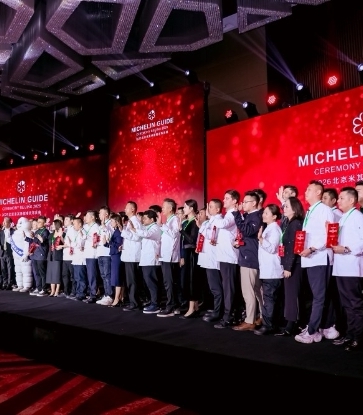Let’s be honest: Cooking is work. As much as cooking can be a passion, a craft, a skill, and even art, creating a dish from scratch can be a labour-intensive process. There’s only one way to put it: Making food for others is truly a labour of love.
In celebration of Labour Day, we ask chefs of MICHELIN-starred restaurants about all the blood, sweat, and tears that go into making their signature dishes—from pithivier to pigeon.

VEA
One MICHELIN Star, MICHELIN Guide Hong Kong Macau 2021
Dish: Abalone pithivier
True to VEA’s Chinese x French culinary philosophy, the abalone pithivier is a testament to VEA’s commitment to excellence. The star ingredients include a whole 27-head Japanese oma abalone and a pithivier, both of which are prepared in the most traditional ways, resulting in an art form that truly represents the best of both worlds.
The most labour-intensive part of the dish is the pivithier, a traditional French pastry that wraps around the braised abalone. “The pithivier is hand laminated with no machine involved,” says Vicky Cheng, chef-owner of VEA. “The only way to make the process more efficient is to do more of it. There’s no shortcut and it’s always going to be time-consuming.”
The preparation work for the abalone is no easy task, either. Each abalone is braised, soaked and bloomed, and takes five to six days to be ready. The cooked abalone is then tightly sealed with spinach leaves by hand, finished with an abalone sauce that is made two days in advance to achieve the perfect consistency.
RELEVANT: MICHELIN Movers and Shakers: Vicky Cheng's WING, Jun Tanaka's Salisterra and More New Ventures

Caprice
Three MICHELIN Stars, MICHELIN Guide Hong Kong Macau 2021
Dish: Racan pigeon from Maison Bellorr cooked in a cocoa pod
A classic French dish reimagined, the Racan pigeon from Loire Valley, the hometown of chef Guillaume Galliot, is cooked in a cocoa pod from Vietnam and served with salsify, puffed potatoes and cocoa jus.
The most laborious step of this signature dish, according to chef Guillaume, is the creation process, which took months to refine. Preparation wise, the pigeon is first pan-fried with a stock base that takes five hours to complete daily. It is then oven-baked in a cocoa shell to bring out the aroma of cocoa. The chocolate sauce serves as a final touch.
What’s chef Guillaume’s tips on nailing labour-intensive recipes? “It is the communication that counts. No matter the circumstances, full house or not, the team has to execute the dish with the same quality every time and anytime.”

Man Wah
One MICHELIN Star, MICHELIN Guide Hong Kong Macau 2021
Dish: Deep-fried matsutake mushroom pudding, or Guo Ja (戈渣)
Since its reopening in February 2021, Man Wah has reintroduced a couple of refined classics, including Guo Ja. Originally made with sea urchin before the renovation, the current version is given a vegetarian twist using Japanese matsutake mushroom.
An age-old recipe of Dashijie passed down to executive chef Wong Wing Keung, Guo Ja is described as a “lost art” with a history that can be traced back to as early as the Ching Dynasty. Traditionally enjoyed as a street snack, Guo Ja is made with egg yolks and corn flour, which creates a pudding mixture that requires at least 14 minutes of continuous hand-stirring. This labour-intensive step is essential to ensure the silkiness of the batter.
To maintain the smooth, custard-like consistency, the hand-stirring part is now replaced by an electric mixer in the Man Wah kitchen. Once the batter is ready, it is then set in the freezer before getting deep-fried until golden brown.
RELEVANT: Man Wah To Reopen With A Focus on Time-Honoured Cantonese Dishes

Tate
Two MICHELIN Stars, MICHELIN Guide Hong Kong Macau 2021
Dish: Brioche with tofu butter
A good first impression begins with bread. At least, that’s the case for restaurants that take their bread service seriously. At Tate, the brioche with tofu butter truly sets the tone for a French dining experience steep in Cantonese influence.
Made in-house daily, the brioche is described by Vicky Lau, chef-owner of Tate, as “one of the most simple yet complicated processes in food making.” Patience is key, as each dough needs to be proofed twice and the temperature has to be low for the butter to mix in while remaining creamy.
The result? An ultra-soft, buttery brioche with a flaky exterior. When torn apart while it’s still warm, the heavenly aroma of quality butter, and milk mixed with yeast and flour exudes a sense of comfort that will leave you craving more.
RELEVANT: Meet The 22 Female Chefs Who Lead Michelin Star Restaurants In Asia

Amber
Two MICHELIN Stars, MICHELIN Guide Hong Kong Macau 2021
Dish: Aka Uni
Aka Uni, an iconic dish that is almost synonymous with Amber, has been on the menu since 2006. With the reopening of Amber in 2019, culinary director Richard Ekkebus tasked himself with a challenge to reinterpret the Aka Uni with a dairy-free approach.
The richness of the cream in the original version has been replaced with enriched soy, achieved by a technique that whips soy into a light cream texture. Hokkaido full-fat milk has been swapped for almond milk, while butter has been replaced with coconut fat. “Animal fat doesn’t allow the quality of the seafood to express fully. The new Aka Uni is cleaner, leaner and more expressive,” says the chef.
Topped with a heaping portion of dome-shaped Daurenki Tsar Imperial caviar, the Aka Uni is layered with crustacean gelee, cream sea urchin and sweet cauliflower purée, all meticulously encased in a white porcelain uni cup.



















